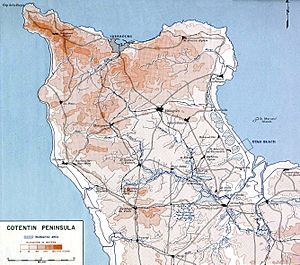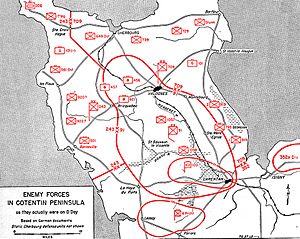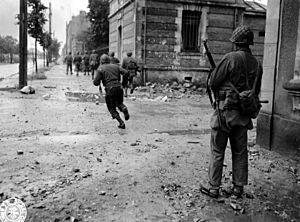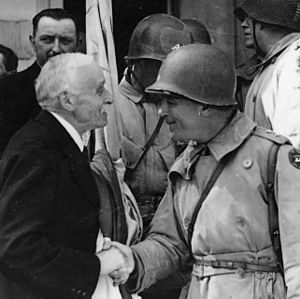Battle of Cherbourg facts for kids
Quick facts for kids Battle of Cherbourg |
|||||||
|---|---|---|---|---|---|---|---|
| Part of the Normandy Campaign, World War II | |||||||
 Cotentin peninsula and port of Cherbourg, 1944 |
|||||||
|
|||||||
| Belligerents | |||||||
| Commanders and leaders | |||||||
| Strength | |||||||
| unknown | 40,000 | ||||||
| Casualties and losses | |||||||
| 2,800 killed 5,700 missing 13,500 wounded Total: 22,000 |
7,000–8,000 killed or missing 30,000 captured Total: 37,000–38,000+ |
||||||
The Battle of Cherbourg was an important fight during World War II. It happened right after the Allied forces landed in Normandy on June 6, 1944. This big landing was called Operation Overlord. During the battle, Allied troops, mostly American soldiers, surrounded and captured the heavily defended port city of Cherbourg. This port was super important for bringing in more soldiers and supplies for the war in Western Europe. The battle was tough and lasted about a month.
Contents
Why Cherbourg Was Important
When the Allies planned their invasion of France, they knew they needed a deep-water port. This kind of port would let them bring in lots of supplies and soldiers directly from the United States. Without it, everything would have to be unloaded in Britain first. Then it would need to be repacked and reloaded onto smaller boats.
Cherbourg was the biggest port they could reach from their landing spots. It was located at the end of the Cotentin Peninsula.
At first, the Allies didn't plan to land directly on the Cotentin Peninsula. This area was separated from the main landings by the Douve river valley. The Germans had flooded this valley to stop airborne troops from landing there. But in January 1944, British Army General Bernard Montgomery changed the plan. He decided to land on the Cotentin Peninsula. This would make their attack front wider. It would also help them capture Cherbourg quickly.
The Landings Begin
In the early morning of June 6, 1944, paratroopers landed at the base of the Cotentin Peninsula. These were soldiers from the US 82nd and 101st Airborne Division. Even though their landings were spread out, they still managed to secure most of the paths. These paths were needed for the US VII Corps to advance from Utah Beach.
The US 4th Infantry Division landed on Utah Beach shortly after sunrise. They had very few casualties. Right after the landings, the main goal for the troops at Utah Beach was to connect with the other Allied forces. These other forces had landed further east.
On June 9, the 101st Airborne Division crossed the flooded Douve river valley. They then captured Carentan the next day. After fierce house-to-house fighting during the Battle of Carentan, the airborne troops took the town. This created a continuous front for the Allies. The front stayed strong even after a German counterattack on June 13. This attack, known as the Battle of Bloody Gulch, included armored units.
Pushing Across the Peninsula
With Carentan captured, the US VII Corps could now push west. Their goal was to cut off the Cotentin Peninsula. Three more infantry divisions arrived to help the Corps. Major General J. Lawton Collins, the Corps Commander, pushed his soldiers hard. He would replace units or fire officers if they moved too slowly.
The German forces facing VII Corps were a mix of different groups. Many had already lost a lot of soldiers fighting the American airborne troops. Very few German tanks or mobile units could be sent here. This was because of the big threat to Caen further east. German infantry reinforcements arrived very slowly. The Germans' own flooding of the Douve river actually helped the Allies. It protected the Allied southern side.
By June 16, there were no more natural barriers in front of the American forces. The German commanders were confused. Erwin Rommel and other leaders wanted to pull their troops back. They wanted to go into the strong Atlantic Wall forts in Cherbourg. Rommel believed they could hold out there for a while. But Adolf Hitler ordered them to hold their current lines.
Late on June 17, Hitler finally agreed that the troops could pull back. But he told them to set up a new, strange defensive line. This line would stretch across the entire peninsula just south of Cherbourg. Rommel disagreed with this order. But he still removed General Wilhelm Fahrmbacher from command. Fahrmbacher was leading the LXXXIV Corps. Rommel thought he was trying to get around Hitler's order.
Attacking Cherbourg
On June 18, the US 9th Infantry Division reached the west coast of the peninsula. This cut off the Cherbourg garrison from any help. Within 24 hours, the 4th Infantry, 9th, and 79th Infantry Divisions were moving north. They advanced on a wide front. There was little resistance on the western side. On the eastern side, the tired German defenders around Montebourg gave up. The Americans found several large hidden stashes of V-1 flying bombs. They also found a V-2 rocket site at Brix.
In just two days, the American divisions were close enough to attack Cherbourg. The German commander of the city, Lieutenant General Karl-Wilhelm von Schlieben, had 21,000 men. But many of these were quickly drafted navy personnel or labor workers. The fighting troops who had retreated to Cherbourg were tired and disorganized. Food, fuel, and ammunition were running low. The Luftwaffe tried to drop supplies, but it wasn't enough. Still, von Schlieben refused to surrender. He began destroying the port so the Allies couldn't use it.
General Collins launched a big attack on June 22. The resistance was strong at first. But the Americans slowly cleared the Germans from their bunkers and concrete forts. Allied naval ships fired at fortifications near the city on June 25. On June 26, a special British force called No. 30 Commando (also known as 30 Assault Unit) attacked Octeville. This was a suburb southwest of Cherbourg. It was where the German navy's intelligence headquarters was located. The Commandos captured it along with many German officers and soldiers. On the same day, the 79th Division captured Fort du Roule. This fort overlooked the city and its defenses. This ended any organized German defense. Von Schlieben was captured.
The harbor forts and the arsenal surrendered on June 29. This happened after two Allied officers, Captain Blazzard and Colonel Teague, tricked the German officers into surrendering. They bluffed about how many men and weapons they had. Some German troops who were cut off outside the defenses held out until July 1.
What Happened Next
The Germans had completely wrecked and mined the port of Cherbourg. Hitler even gave a special award, the Knight's Cross, to Rear Admiral Walter Hennecke the day after he surrendered. Hitler said it was "a feat unprecedented in the annals of coastal defense." The port could only be used a little bit by the middle of August. But the first ships were able to use the harbor in late July. Even so, the Germans had suffered a major defeat. This was partly because the Allies quickly built up their forces. It was also because of Hitler's strict orders.




